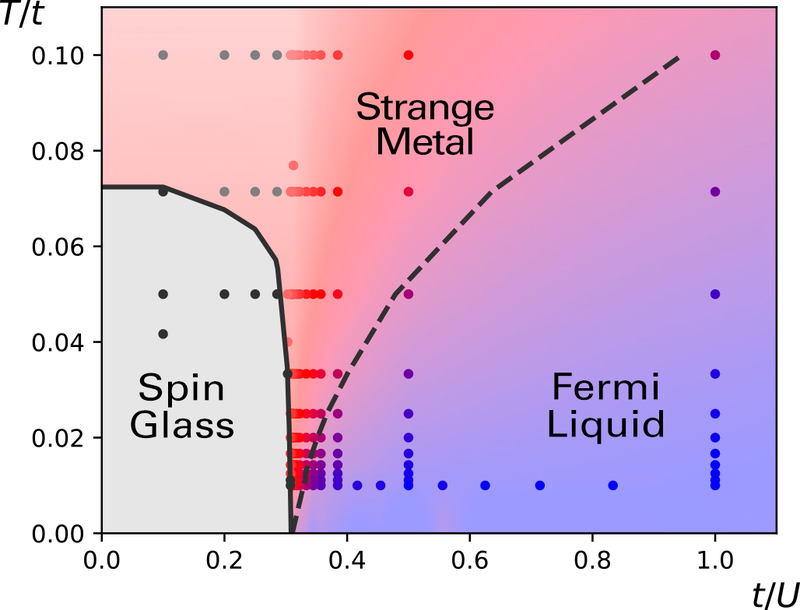Jul 24 2020
Strange metals are odd, even by the standards of quantum physicists. The materials are associated with high-temperature superconductors and have fascinating links to the properties of black holes.
 A diagram showing different states of matter as a function of temperature, T, and interaction strength, U (normalized to the amplitude, t, of electrons hopping between sites). Strange metals emerge in a regime separating a metallic spin glass and a Fermi liquid. Image Credit: P. Cha et al./Proceedings of the National Academy of Sciences 2020.
A diagram showing different states of matter as a function of temperature, T, and interaction strength, U (normalized to the amplitude, t, of electrons hopping between sites). Strange metals emerge in a regime separating a metallic spin glass and a Fermi liquid. Image Credit: P. Cha et al./Proceedings of the National Academy of Sciences 2020.
According to the laws of quantum mechanics, electrons present in strange metals release energy as quickly as they are allowed to, and in contrast to the electrical resistivity of ordinary metals, a strange metal’s electrical resistivity is proportional to the temperature.
In condensed matter physics, it is extremely challenging to achieve a theoretical understanding of strange metals. Researchers at the Flatiron Institute in New York City and Cornell University have now used advanced computational techniques to solve the first-ever robust theoretical model of strange metals.
The study, which was published in the Proceedings of the National Academy of Sciences on July 22nd, 2020, shows that strange metals are a new state of matter.
The fact that we call them strange metals should tell you how well we understand them. Strange metals share remarkable properties with black holes, opening exciting new directions for theoretical physics.
Olivier Parcollet, Study Co-Author and Senior Research Scientist, Center for Computational Quantum Physics, Flatiron Institute
Apart from Parcollet, the team included Cornell doctoral student Peter Cha, CCQ associate data scientist Nils Wentzell, CCQ director Antoine Georges, and Cornell physics professor Eun-Ah Kim.
In the realm of quantum mechanics, electrical resistance builds when electrons collide with things. When electrons travel through a metal, they tend to bounce off impurities or other electrons in the metal. The electrical resistance of the material is inversely proportional to the time taken between these collisions.
The electrical resistance of typical metals increases with temperature and follows a complex equation. However, in rare cases—for example, upon heating a high-temperature superconductor just above the point at which it stops superconducting—the equation turns quite straightforward.
The electrical conductivity of a strange metal is directly related to temperature and to two basic constants of the universe: Boltzmann’s constant and Planck’s constant. Thus, strange metals are also called Planckian metals.
Although models of strange metals have been there for several decades, existing methods were not useful to accurately solve such models. In the case of quantum entanglements between electrons, physicists cannot treat the electrons individually, and the enormous number of particles in a material renders the calculations much more laborious.
Cha and his team used two different techniques to solve the issue. They first used a quantum embedding technique based on concepts proposed by Georges in the early 1990s. Using this technique, rather than performing detailed computations over the entire quantum system, physicists carry out detailed calculations using just a few atoms and treat the remaining system more simply.
A quantum Monte Carlo algorithm (named after the Mediterranean casino), which involves using random sampling to find the answer to a problem, was then used by the researchers. They solved the model of strange metals down to absolute zero (−273.15 °C), the unattainable lower limit for temperatures in the universe.
The ensuing theoretical model shows the occurrence of strange metals as a new state of matter that borders two familiar phases of matter: Fermi liquids and Mott insulating spin glasses.
We found there is a whole region in the phase space that is exhibiting a Planckian behavior that belongs to neither of the two phases that we’re transitioning between. This quantum spin liquid state is not so locked down, but it’s also not completely free. It is a sluggish, soupy, slushy state. It is metallic but reluctantly metallic, and it’s pushing the degree of chaos to the limit of quantum mechanics.
Eun-Ah Kim, Physics Professor, Cornell University
The new study could enable physicists to gain better insights into the physics of higher-temperature superconductors.
Strikingly, the study has connections to astrophysics. Similar to strange metals, black holes display properties that rely only on temperature and the Boltzmann and Planck constants, for example, the period for which a black hole “rings” after fusing with another black hole.
The fact that you find this same scaling across all these different systems, from Planckian metals to black holes, is fascinating.
Olivier Parcollet, Study Co-Author and Senior Research Scientist, Center for Computational Quantum Physics, Flatiron Institute
Journal Reference:
Cha, P., et al. (2020) Linear resistivity and Sachdev-Ye-Kitaev (SYK) spin liquid behavior in a quantum critical metal with spin-1/2 fermions. Proceedings of the National Academy of Sciences. doi.org/10.1073/pnas.2003179117.